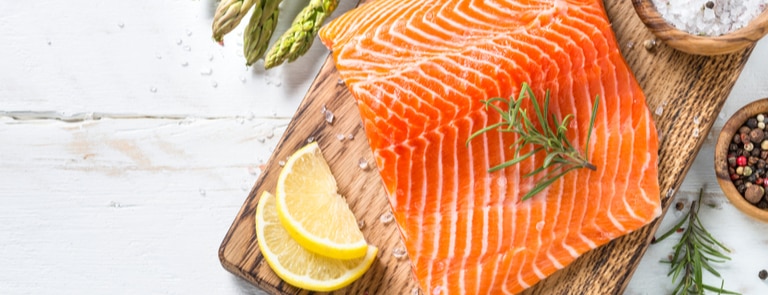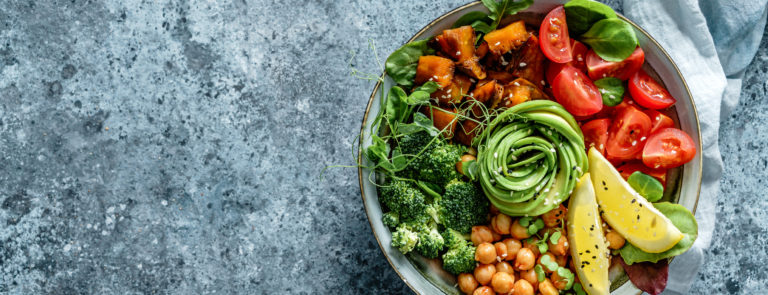15% off €25
6 of the healthiest fish

Fish is packed full of omega 3 fatty acids, as well as being rich in vitamin D, vitamin B2, calcium and phosphorus.
It is also a great source of minerals too, including iron, zinc, iodine, magnesium and potassium.1
The NHS recommends that a healthy balanced diet should include at least two portions of fish each week and that one of these portions should be oily fish.2
Ok, so now know that incorporating fish into your diet is good for you - but there are so many to choose from! Which is the best?
Here we have a look at some of the healthiest types of fish.
-
Salmon
Not only is salmon one of the healthiest types of fish, it is also one of the most readily available.
Salmon is low in calories and saturated fat as well as being a great source of protein.
It is also rich in vitamin B12, potassium, iron and vitamin D.3 And better still, it is one of the oily fish that we talked about earlier.
How to add salmon to your diet
There are lots of easy ways to add salmon to your diet as it is readily available in many different forms, including fillet, tinned and smoked.
Add smoked salmon to scrambled eggs for breakfast or eat a fillet of salmon with vegetables for dinner.
The healthiest way to cook salmon is in the oven. This healthy canned fish can also be added to a salad for a light lunch.
-
Cod
This popular white flaky fish is not just one of the best tasting fish but it is also a good source of phosphorus, niacin and vitamin B12 as well as being rich in protein.
Three ounces of cooked cod contains 15-20 grams of protein.4
The body uses protein for muscle maintenance, repair and growth and so it is an essential part of your diet.
You should try to up your protein intake if you take regular exercise or live a very active lifestyle.
How to add cod to your diet
We know what you are thinking – battered cod with chips and mushy peas from the chippie – but unfortunately this is not the healthiest way to eat cod. Maybe as a special treat but not every week!
Instead, you might like to try a healthier version of fish and chips, by eating a fillet of cod with new potatoes and garden peas for dinner.
You could even try making a lower fat version of batter with crushed cornflakes for a delicious fakeaway.
-
Mackerel
The next oily fish on our list is mackerel. This nutritious fish has high levels of essential fatty acids which can support endurance and aid recovery during exercise, as well as helping to maintain the appearance of the skin.5
How to add mackerel to your diet
You can buy mackerel fillets in tins from the supermarket and they sometimes come in a sauce like tomato or sweet chilli.
You can add these fillets to salad, eat as a snack, or you can pan fry fresh mackerel fillets to eat with vegetables.
-
Trout
Trout is closely related to salmon and it is one of the healthiest fish to eat.
It is a great source of protein, niacin, vitamin B12 and omega 3 fatty acids. Niacin is important in our bodies as it helps to convert the food we eat into energy and it also helps to support digestion, skin and nerve functions in the body.6
How to add trout to your diet
Trout can be bought whole or as fillets.
The healthiest way to eat trout is by baking it in the oven and then serving with potatoes and either vegetables or salad.
-
Tuna
A favourite of many, tuna not only tastes delicious but it is also a great source of protein whilst containing almost no fat.
It is full of all of the essential amino acids that the body uses for lean muscles and it contains omega 3 fatty acids.7 People who have muscle mass also tend to have a faster metabolism.
How to add tuna to your diet
You can buy tinned tuna as well as fresh tuna steaks.
Tinned tuna is super-versatile and can be added to pretty much anything! Use in sandwiches, salads, as a jacket potato topping or even add it to pasta.
Fresh tuna steaks have a meaty texture and are great when accompanied with potatoes and vegetables or with noodles, chillies, veg and seasoning for a more Asian-inspired dish.
-
Oysters
Famed for being a natural aphrodisiac, oysters are good for you in other ways too! They are also the only shellfish to make it onto our list.
Oysters are rich in omega 3 and they are a source of vitamin D as well as iron.8
The body uses iron to make haemoglobin, a protein within red blood cells, which carries oxygen to all parts of the body.9
How to add oysters to your diet
Ok, so you will probably not be eating oysters every week but they are great as a special treat, perhaps as an appetiser before a meal.
Add a splash of vinegar, lemon juice or hot sauce to taste.
Last updated: 9 April 2021
- https://www.doh.wa.gov/communityandenvironment/food/fish/healthbenefits
- https://www.nhs.uk/live-well/eat-well/fish-and-shellfish-nutrition/
- https://www.webmd.com/food-recipes/benefits-salmon
- https://www.healthline.com/health/food-nutrition/11-best-fish-to-eat#cod
- https://mackerel.fromnorway.com/norwegian-mackerel/nutrition/
- https://lacrosseallergy.com/what-to-expect/diet-and-nutrition-counseling-services/trout-superfood-of-the-month/
- https://www.thespruceeats.com/is-tuna-healthy-2122477
- https://www.onemedical.com/blog/eat-well/healthy-fish-eating-guide
- https://ods.od.nih.gov/factsheets/Iron-Consumer/



